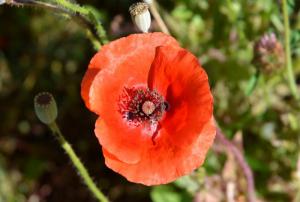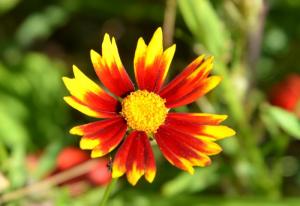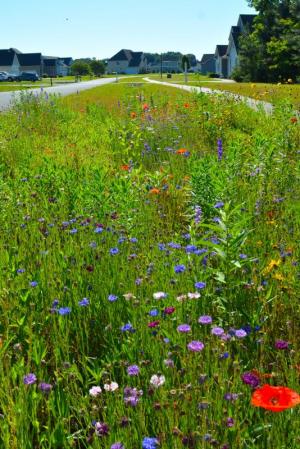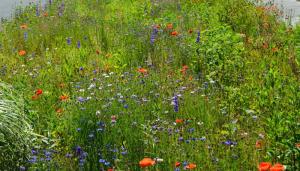Pollinator gardens are typically planted to help pollinators combat the continued loss of natural habitat. For one pollinator garden outside Milton, it’s been done to attract birds.
“It’s all about the birds,” said Linda Rosenberg, laughing. “The bugs like the flowers. The birds like the bugs.”
Rosenberg’s house is at the cul-de-sac end of a neighborhood off Hudson Road. She’s planted a wildflower meadow in the drainage ditch in front of her house. She and her wife Judy, a retired pharmacist who lives here full time, have owned the house for seven years. Rosenberg still travels back and forth to Pennsylvania, where she works in the criminal justice system as a probation hearing officer. Birding, she said, is a way to relax.
The ease of the program is another reason she’s participating, said Rosenberg. These are basically just weeds that have these beautiful flowers, she said.
“You don’t need to be an expert,” she said.
In the birding world, Rosenberg would be considered a chaser – a person who will travel to catch a glimpse of a bird rare to the area. Earlier this year, she traveled to Boothbay Harbor, Maine, to see a Steller’s sea eagle, a rare bird that’s native to Eastern Asia and larger than a bald eagle. Rosenberg said she was able to see the bird. It’s got this big yellow beak, she said, making a jellyfish-like swimming motion with her hand over her nose showing the size.
Rosenberg said she was inspired to plant the wildflowers after participating in the University of Delaware’s master naturalist program. One of the fundamental principles learned in this program is the importance of native plants in the local ecosystem, she said.
There are different flowers blooming at different times of the summer, and it all gets mowed down when they’re all done in the fall, said Rosenberg.
The bugs attract bird species that bird feeders otherwise do not, said Rosenberg, quickly listing off a number – hummingbird, grosbeaks, orioles, finches, sparrows. There’s more, she said.
This is the second year she’s planted the wildflowers in the ditch. She had to get permission from the homeowners association to plant the meadow.
“Wouldn’t it be cool if this all looked like this?” said Rosenberg, pointing to the rest of the neighborhood’s thousands of feet of drainage ditch.

























































